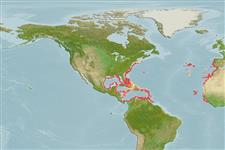Actinopterygii (ray-finned fishes) >
Perciformes (Perch-likes) >
Ariommatidae (Ariommatids)
Etymology: Ariomma: Greek, ari = very, strength, superiority + Greek, omma = eyes (Ref. 45335).
Environment / Climate / Range
Ecology
Marine; bathydemersal; depth range 180 - 600 m (Ref. 7347), usually 180 - 550 m (Ref. 7251). Deep-water, preferred ?; 42°N - 8°N
Eastern Atlantic: Mauritania to Angola; possibly straying to southern Africa (Ref. 4412). Western Atlantic: New York and northern Gulf of Mexico in USA to Panama (Ref. 7251), [extending to the northern coast of South America according to Ref. 13628], up to Uruguay (Ref. 47377). Not occurring in the West Indies (Ref. 7251).
Size / Weight / Age
Maturity: Lm ? range ? - ? cm
Max length : 30.0 cm TL male/unsexed; (Ref. 7251); common length : 25.0 cm SL male/unsexed; (Ref. 47377)
Inhabits deep waters, usually on soft bottoms (Ref. 2683). Feeds mainly on small crustaceans (Ref. 3547). Larvae and young are epipelagic, adults demersal or benthopelagic (Ref. 47377).
Life cycle and mating behavior
Maturity | Reproduction | Spawning | Eggs | Fecundity | Larvae
Oviparous, gonochorous, with pelagic eggs (Ref. 101194).
Haedrich, R.L., 1990. Ariommidae. p. 1019-1020. In J.C. Quero, J.C. Hureau, C. Karrer, A. Post and L. Saldanha (eds.) Check-list of the fishes of the eastern tropical Atlantic (CLOFETA). JNICT, Lisbon; SEI, Paris; and UNESCO, Paris. Vol. 2. (Ref. 7347)
IUCN Red List Status (Ref. 115185)
CITES (Ref. 94142)
Not Evaluated
Threat to humans
Harmless
Human uses
Fisheries: minor commercial
More information
ReferencesAquacultureAquaculture profileStrainsGeneticsAllele frequenciesHeritabilityDiseasesProcessingMass conversion
Tools
Special reports
Download XML
Internet sources
